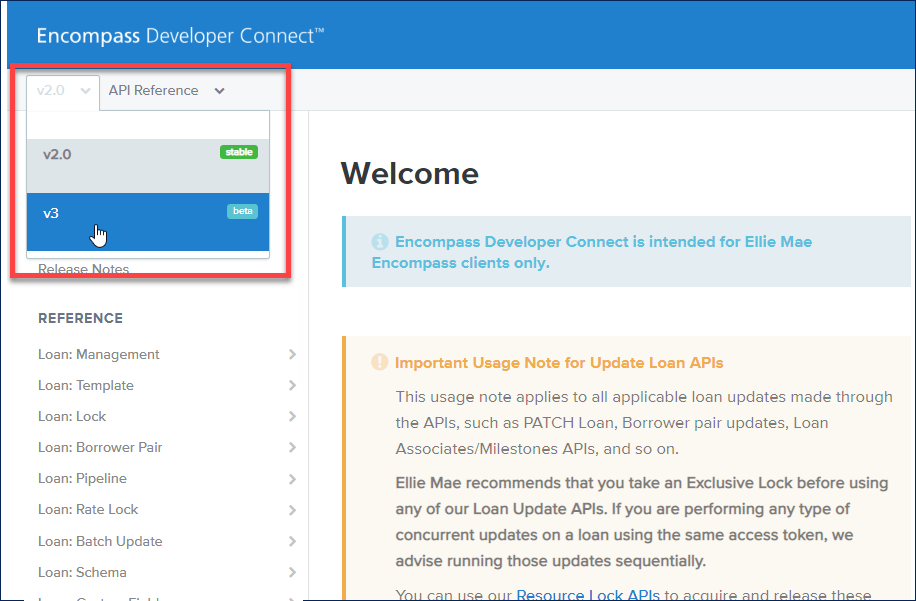November 19.4 Major Release
Introducing New Version 3 (V3) APIs
Early access to Encompass Developer Connect V3 APIs will be available in this release. The new and improved V3 APIs, which will be available under the "V3" section of the API Documentation can be used with the same oAuth token flow. The v3 APIs will simply have a new version in the API endpoints, and may have different data contracts from their v1 counterparts. V3 APIs ensure better performance, stability, ease of use and consistency for consuming the Developer Connect APIs. There will be a gradual roll-out plan for the v3 APIs.
Using V3 APIs to Manage Attachments and Documents
The V3 APIs utilize cloud storage for loan attachments. Cloud storage makes it possible to store and retrieve loan attachments faster, and requires less resources from the client workstation to process documents.
Enabling V3 Could Storage APIs for Early Access
The V3 Cloud Storage APIs will be generally available in 2020. For early access on Encompass 19.4 R2T Smart Client test environments, contact your Ellie Mae Relationship Manager.
Viewing Attachments in Encompass
Developer Connect V3 APIs work seamlessly with Encompass. Whether accessing attachments from the media server or cloud storage, the flow is the same with V3 APIs. With cloud storage, Encompass users will notice improved performance. They may also notice subtle changes in appearance to the Encompass eFolder and document viewer for new loans.
Using Both V1 and V3 APIs
You can start the consumption of the V3 APIs on your R2T instances without turning on Cloud Storage as the V3 APIs are backward compatible. However, the V1 APIs used to manage attachments will no longer work once the Encompass instance is enabled for Cloud Storage/ Skydive, and loans will be using Cloud Storage. Encompass Developer Connect V1 and V3 APIs can be used simultaneously. API calls will be directed to the correct server depending on the API version. Attachments for Loans using media server can still be managed with the V1 APIs, and attachments for loans using cloud storage need to use the V3 APIs. Documents can be managed using V1 or V3 APIs, and the workflow will not break.
For this initial release, we are offering the following V3 APIs:
eFolder Documents
• Get List of Documents
• Get a Document
• Get Comments to a Document
• Manage Documents
• Manage Attachments Linked to a Document
• Add Comments to a Document
eFolder Attachments
• Get list of attachments
• Get Attachment
• Manage Attachment
• Upload an Attachment
• Download an Attachment
Accessing the V3 APIs
The V3 APIs will be available from the Developer Connect portal. A new menu at the top left of the Developer Connect Welcome page allows you to select the version you want to view. You can toggle between V1 and V3 using this menu.

For additional information about the V3 Cloud Storage APIs, check out the November blog post, Introducing Cloud Storage for Loan Attachments.
New V1 APIs
Export Attachments
• Create an export job with a list of attachments within a loan
• Get the status of the export job
Enhancements to V1 APIs
EPPS Loan Qualifier Contract Changes
The custom attribute in the EPPS Loan Qualifier contract is deprecated in this release. The custom attribute included the ratesCustomInput object and any custom rate details provided in the loan. This attribute will be replaced in a future release.
Support for Avantus Credit Partner
With this release, the Developer Connect Services API will support ordering and retrieving consumer credit reports from Avantus (CBCT).
New Webhook Notification for Moving a Loan
A new event type is being added to Webhooks notifications so that lenders can receive a notification when a loan is moved from one folder to another in Encompass. This enhancement is implemented by the new move event type. The move event type will be available for Create a Subscription, Update a Subscription, and Get Resource for Loan APIs.
Updates to Get Loan Metadata API
Two new attributes are being added to the Get Loan Metadata API so that lenders can query and view loans according to the user ID (createdBy) of the person who created the loan and the current version/ loan sequence number (loanFileSequenceNumber).
